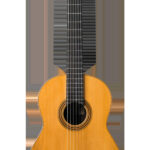Like many guitarists, I’ve been on a long and winding journey to find my perfect guitar pick. It’s a surprisingly personal choice, and if you’re anything like me, you’ve probably experimented with a drawer full of different plectrums. From the slippery grip of Clayton 1.0 mm picks to the attack of Dunlop Stubby Jazz picks, and even novelty rubber picks, I tried it all. Nylon, textured grips, super slick surfaces, thin, thick – the options seemed endless.
Eventually, I landed on Dunlop Tortex picks. I cycled through the .66mm, .73mm, and .83mm before settling on the .83mm. The feel, the tone, and yes, even the green color and the little turtle logo appealed to me. For years, I was content.
Then, I stumbled upon a video of Nick Hipa from As I Lay Dying. He mentioned using the M3 (Jazz III size) version of the .88mm green Tortex pick, highlighting its sharp tip for picking accuracy. That was a lightbulb moment. I realized I’d been focusing on tone and grip, but hadn’t fully considered picking accuracy as a key factor in choosing the Best Guitar pick. I made the switch and haven’t looked back. This pick has been my go-to for years now.
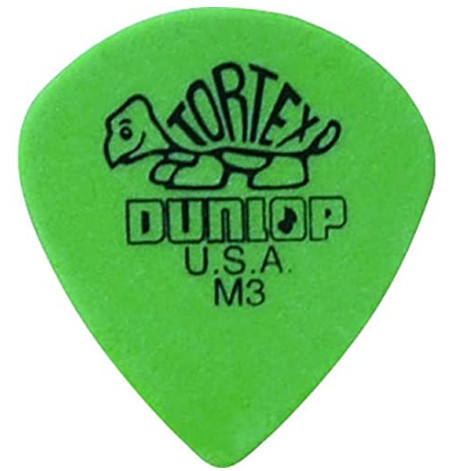 Dunlop Tortex M3 Guitar Pick for Precision and Control
Dunlop Tortex M3 Guitar Pick for Precision and Control
But why does such a small piece of plastic (or other material) cause so much debate and experimentation? Let’s dive into the world of guitar picks and explore why guitarists are so particular and how you can find the best guitar pick for your playing style.
Why Are Guitarists So Picky About Picks?
Let’s face it, guitarists are picky about everything! String gauge, brands (even if many come from the same factory), tuners, fret material – if there’s an option, we have an opinion.
But this pickiness stems from a valid reason: every piece of gear is a tool that shapes our tone and playing experience. Guitar picks are extensions of our hands, the direct link between our musical ideas and the strings. They empower us to play the riffs, licks, and chords that inspire us, and ultimately, to create our own music.
If you’re like me, you enjoy experimenting with different sounds and tools. That’s probably why you have a pedalboard overflowing with delays and a collection of overdrives. We tell ourselves they are “different tools for different jobs,” but deep down, we know it’s a wonderful, inspiring, gear-hoarding passion.
And when it comes to guitar picks, their affordability makes experimentation incredibly accessible. Buying a variety pack to discover your preference is a worthwhile investment in your tone and playing.
Exploring Guitar Pick Materials for Different Tones
Guitar picks can be crafted from a surprising range of materials, but some are far more common and popular than others. Each material offers a unique feel and sonic characteristic.
Celluloid: Classic Tone
Celluloid is the traditional material behind those classic tortoise shell picks. Known for producing a brighter tone, celluloid is a vintage favorite.
Nylon: Grip and Warmth
Nylon picks, such as the widely used Dunlop Standard Picks, are popular for their distinctive grip texture and warmer tone compared to celluloid.
Acetal (Tortex): Durability and Balanced Tone
Acetal is the material used in Tortex and similar picks. This material, often enhanced with a powder grip, is favored for its durability and balanced tonal characteristics. Tortex picks are known for lasting longer than some other materials.
Ultem: Stiffness and Brightness
Ultem picks are less common but offer unique properties. They are very stiff and produce a bright tone, regardless of thickness.
Acrylic: Clarity and Durability
Acrylic picks are clear, dense, and durable. They can be tinted in various colors and, due to their slick nature, often feature textured grips. Acrylic picks are known for their clear and articulate sound.
Exploring Exotic and Unique Guitar Picks
Beyond the standard materials, there’s a world of niche and “exotic” guitar picks that offer unique playing experiences. Here are a few interesting examples:
Purple Plectrums: Ergonomic Thickness
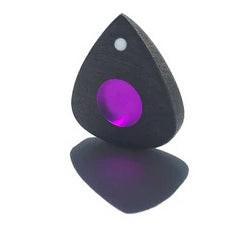 Purple Plectrums for Enhanced Grip and Reduced Fatigue
Purple Plectrums for Enhanced Grip and Reduced Fatigue
Purple Plectrums are exceptionally thick, ranging from 6mm to 9mm. This substantial thickness offers a more ergonomic grip, potentially reducing hand fatigue during long playing sessions.
Dragon’s Heart Guitar Picks: Versatile Design and Longevity
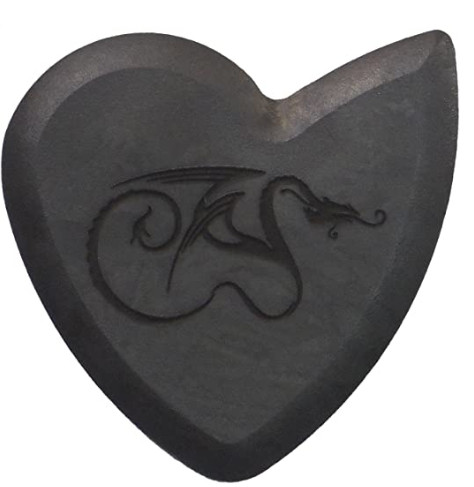 Dragon's Heart Guitar Pick with Multiple Playing Edges
Dragon's Heart Guitar Pick with Multiple Playing Edges
The Dragon’s Heart pick boasts a unique shape and 3mm thickness, along with a claimed 1000-hour lifespan. Its design offers a sharp point and two rounded variations, providing tonal versatility.
Chibson Jumbo Guitar Pick: For the Novelty Seeker
 Oversized Chibson Jumbo Guitar Pick for a Novelty Experience
Oversized Chibson Jumbo Guitar Pick for a Novelty Experience
The Chibson Jumbo Guitar Pick is more of a novelty item. Its oversized nature is less about practical playing and more about fun and visual appeal.
Understanding Guitar Pick Sizes and Their Impact on Tone
Guitar picks come in a wide range of thicknesses, and size is a crucial factor influencing your tone. Combined with material, pick thickness offers a spectrum of subtle yet noticeable tonal variations.
Generally, pick sizes are categorized into four groups: Thin, Medium, Heavy, and Extra Heavy.
- Thin Picks: .40mm to .60mm
- Medium Picks: .60mm to .80mm
- Heavy Picks: .80mm to 1.20mm
- Extra Heavy Picks: Above 1.20mm
Thinner picks generally produce a brighter tone with less body. A .40mm pick, for instance, will sound brighter and less full than a thicker pick. Acoustic guitarists often use thin picks for aggressive strumming to achieve a bright, cutting sound.
As you increase pick thickness, your tone gains body. While material still affects brightness, thicker picks tend to sound less bright than thinner ones of the same material.
This difference is due to how much the pick moves the strings. A thin, flexible pick (.40mm) bends easily and can’t displace the string as much as a rigid, thicker pick (1.00mm). The thicker pick transfers more energy to the string, resulting in a fuller sound. Experiment by strumming chords with both thin and thick picks to hear the difference.
Both extremely thin and extremely thick picks can hinder speed. Thin picks are too flexible and “give in” to string resistance, limiting speed. Conversely, very thick picks require more movement to travel across the strings, potentially slowing down your picking speed.
However, pick design plays a role. The Purple Plectrum, despite its thickness, has a sharp point to mitigate speed limitations. But a standard 1.50mm pick, uniformly thick, will have more drag.
Personally, I prefer a middle-ground thickness, around .88mm. For me, it offers a balance of stability and speed.
Exploring Different Guitar Pick Shapes for Enhanced Playability
Beyond material and thickness, guitar picks come in various shapes, each influencing grip and picking attack. The sheer variety can seem overwhelming, but understanding the basics helps narrow down your choices.
Classic/Standard Pick Shape: The Versatile All-Rounder
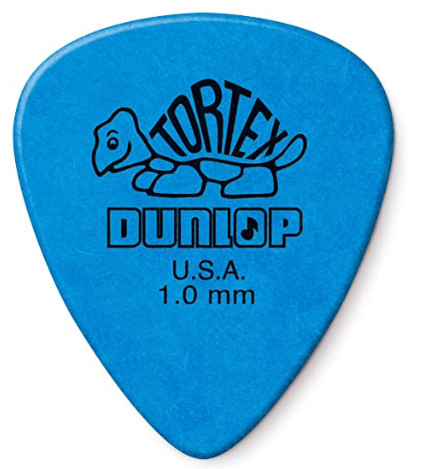 Standard Shape Tortex Guitar Pick for Comfortable Grip
Standard Shape Tortex Guitar Pick for Comfortable Grip
The Classic/Standard pick shape is the most common and versatile. It fits comfortably between the thumb and index finger, and you can adjust your grip for varying levels of control.
Jazz Pick Shape: Precision and Articulation
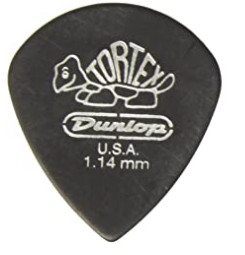 Jazz Shape Tortex Guitar Pick for Picking Accuracy
Jazz Shape Tortex Guitar Pick for Picking Accuracy
Jazz picks, smaller and with a sharper point than standard picks, are favored by many metal and jazz players for their enhanced picking accuracy. They take some getting used to due to their smaller size (about 75% of a standard pick).
Tri-Tip/Triangle Pick Shape: Comfortable Grip and Versatility
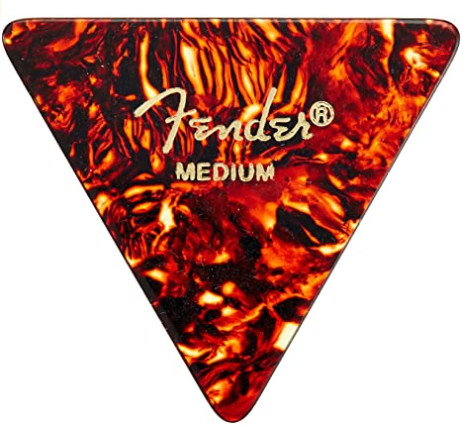 Triangle Shape Fender Guitar Pick for Larger Grip Area
Triangle Shape Fender Guitar Pick for Larger Grip Area
If standard or jazz picks feel too small, Tri-Tip/Triangle picks offer a larger gripping surface for increased comfort.
Rounded triangle picks, like the Dunlop Ultex Triangle, provide a different feel and attack compared to pointed triangle picks.
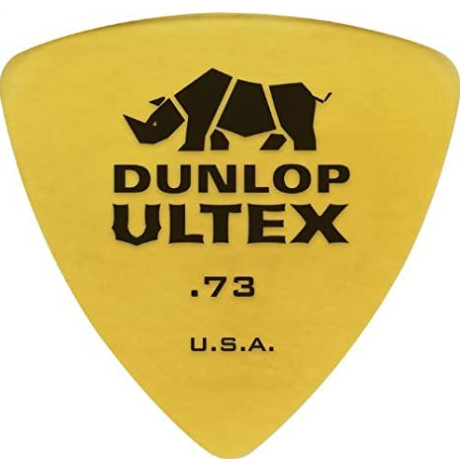 Rounded Triangle Dunlop Ultex Guitar Pick for a Unique Feel
Rounded Triangle Dunlop Ultex Guitar Pick for a Unique Feel
How to Choose the Best Guitar Pick for You: Recommendations and Tips
Finding your best guitar pick often involves years of experimentation. Working at a music store allowed me to easily sample countless picks. I encourage you to do the same – try different picks on both electric and acoustic guitars.
For years, I even carried two different pick types to gigs: a lighter one for acoustic and a heavier one for electric.
To give you a starting point, here are some recommendations based on playing style and needs. Remember, these are subjective guidelines, but they can help you narrow your search.
Best Guitar Pick for Shredding and Fast Playing
For fast, articulate playing (“shredding”), you’ll want a firmer pick that isn’t excessively thick, generally in the .80mm to 1.00mm range. A sharper point is also beneficial for precision. Many lead guitarists prefer Jazz or standard-sized picks in this thickness range.
Best Guitar Pick for Acoustic Guitar Strumming
For acoustic strumming, the options are vast. If you strum aggressively, avoid picks thicker than .80mm. Lighter strummers might avoid going below .80mm. Average-velocity strummers have a wide range to explore.
A good starting point for acoustic guitar is a .66mm or .73mm pick. To my ears, the .73mm offers a better balance of brightness and body for acoustic playing.
Best Guitar Pick for Joint Pain or Arthritis
For players experiencing wrist pain or arthritis, ergonomic picks are crucial. Larger picks like Triangle, Dragon’s Heart, and Purple Plectrum picks can be easier to grip and require less squeezing, reducing hand strain. Some of these still offer a sharp point for picking accuracy.
Best Guitar Pick for Grip and Avoiding Drops
If you frequently drop your pick, consider larger picks or picks with textured grips. Textured grip picks feel almost like sandpaper, providing a secure hold even with sweaty hands.
Experimentation is Key to Finding Your Best Guitar Pick
The beauty of guitar picks is their affordability. Unlike strings or pedals, trying different picks is inexpensive and requires no installation. Purchase a mixed pack with various materials, sizes, and shapes to begin your exploration.
Dedicate a week to each new pick, depending on your playing frequency. This allows time to adjust and truly assess its feel and tone. Even picks that initially feel “wrong” are worth trying.
Using an unfamiliar pick can spark new musical ideas and inspiration. Any variation in your usual routine can lead to creative breakthroughs.
Plus, having a pile of picks means you’ll always have ammo to playfully flick at your bandmates. The benefits are endless!
Remember, finding the best guitar pick is a personal journey. Experiment, explore, and enjoy the process of discovering what works best for your unique playing style and sound.


